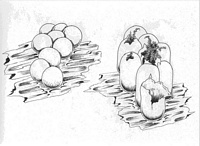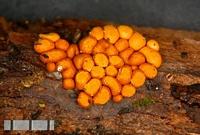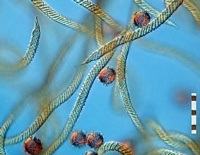|
 Trichia favoginea Trichia favoginea
SynonymsTrichia affinis
Trichia persimilis
Lycoperdon favogineum
BiostatusPresent in region - Indigenous. Non endemic
Images (click to enlarge)
Caption: Two small fruitings of Trichia favoginea that display the variation in the shape of the sporangium associated with this species complex. The sporangia on the right are about 1.5 mm tall.
Owner: S.L. Stephenson | 
Owner: J.A. Cooper | 
Owner: J.A. Cooper |
Article: Stephenson, S.L. (2003). Myxomycetes of New Zealand. Fungi of New Zealand. Ngā Harore o Aotearoa 3: xiv + 238 p. Hong Kong: Fungal Diversity Press.
Description: Fruiting body a sessile sporangium, usually densely crowded but occasionally gregarious, subglobose to ovate, to clavate or cylindrical, bright yellow-brown, more or less shining, 0.5–1.0 mm in diameter and up to 2 mm tall. Hypothallus contiguous for a group of sporangia, membranous, transparent to colourless. Peridium membranous, transparent, yellow, nearly smooth. Capillitium yellow, consisting of free elaters 4–8 µm in diameter, marked with 3 to 5 smooth to spinulose spiral bands, tips of elaters pointed, blunt, or rounded and spinulose. Spores yellow to ochraceous or orange in mass, pale to bright yellow by transmitted light, coarsely reticulate, 13–15 µm in diameter. Plasmodium white or yellow.
Habitat: Decaying wood or bark; occasionally fruiting on leaf litter or soil; in New Zealand not uncommon on decaying fronds of nikau palm.
Distribution: Widely distributed in temperate regions of both hemispheres and in montane regions of the tropics (Martin & Alexopoulos 1969). First reported (as Trichia affinis) from New Zealand by Colenso (1892), based on a specimen collected in Wairarapa/Rangitikei. Also known from the Kermadec Islands, Auckland, Coromandel, Waikato, Wellington, Nelson Westland, South Canterbury, Dunedin, Southland, Stewart Island (Lister & Lister 1905), and Campbell Island.
Notes: The coarsely reticulate spores distinguish Trichia favoginea from all other species of Trichia that produce sessile sporangia. Trichia verrucosa, with similar spores, is almost always stalked. It should be noted that T. favoginea is best considered a species complex (Farr 1958), and the number of taxonomic entities recognised varies among different authors. Martin & Alexopoulos (1969) considered T. favoginea as a single variable species that encompasses two other species (T. affinis and T. persimilis) usually recognised as distinct by most European authors (e.g., Nannenga-Bremekamp 1991, Ing 1999). Although the former concept is the one followed herein, typical expressions of T. persimilis and T. affinis do appear to be sufficiently distinct to be readily identifiable. Both are characterized by sporangia that are globose to subglobose, whereas those of T. favoginea are more or less cylindrical. Moreover, T. favoginea has larger elaters (usually 6–8 µm in diameter as opposed to 4–6 µm for T. persimilis and T. affinis) and the reticulations on the spores are somewhat different (Farr 1958). Trichia persimilis and T. affinis can be separated on the basis of the latter having smaller and more complete reticulations on the spores, and the former usually occurring on wood at a much earlier stage of decomposition (Ing 1999). As pointed out by Mitchell (1992), these morphological and ecological distinctions do not seem especially apparent for specimens from New Zealand, although forms that would be considered as absolutely typical for T. favoginea do not appear to be particularly common (Stephenson, unpub. data).
|